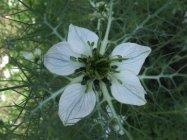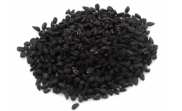 Nigella sativa commonly known as Black cumin or Black seed has a long history of medicinal and culinary use in the Middle East and Asia, commonly appears on breads such as tsoureki (τσουρέκι), which is prepared during the Easter celebrations in Greece and Cyprus, Naan bread in India and çörek buns in Turkey.
Nigella sativa commonly known as Black cumin or Black seed has a long history of medicinal and culinary use in the Middle East and Asia, commonly appears on breads such as tsoureki (τσουρέκι), which is prepared during the Easter celebrations in Greece and Cyprus, Naan bread in India and çörek buns in Turkey.
In India and Middle East, it was traditionally used to treat indigestion, loss of appetite, fever, diarrhoea, general weakness, chest congestion, asthma and arthritis.

Therapeutic Activity
Nigella sativa seems to attribute its therapeutic activity to thymoquinone, the major active constituent of the volatile oil but the whole plant demonstrates:
- Anti-inflammatory
- Analgesic
- Antipyretic
- Antimicrobial
- Decreases triglycerides
- Hypocholesterolemic
- Hypoglycaemic
- Antioxidant
- Digestive
- Anthelmintic
- Carminative
- Diuretic
- Emmenagogue
- Galactagogue
- Chemoprevantative and antitumour activity (Antineoplastic)
- Protection against nephrotoxicity and hepatotoxicity induced by either disease or chemicals
Clinical trials
According to clinical trials, Black cumin improved the symptoms of allergic rhinitis, reduced hyperlipidaemia (high lipid blood levels) and has shown beneficial results with type 2 diabetes. However, more clinical trials are needed to confirm findings.
Other medicinal uses
- reduction of central obesity (3 g/day, taken for 3 months)
- Type 2 diabetes (2 g/day dose)
- fasting blood glucose decreased significantly
- HbA1c decreased by 1.5% at the end of the 12 weeks (p < 0.0001
- insulin resistance was reduced (p < 0.01) and beta-cell function was increased (p < 0.02) at 12 weeks
- H. pylori infection (2 g/day)
- Worm infestation
Caution
- Not to be used during pregnancy

